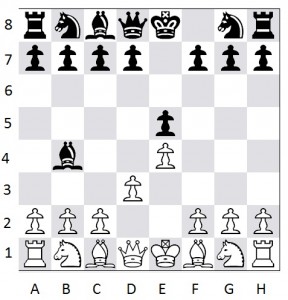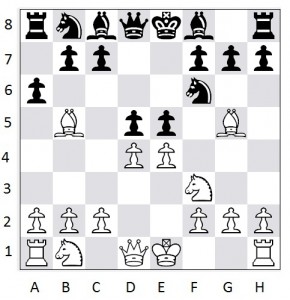Now that you know how the pieces move (at least, you do if you read the last 2 blogs… if you haven’t read them, please go back and do so now), you need to learn how to win! There are two ways to win: 1) get your opponent in checkmate, 2) your opponent realizes it’s futile for him/her to continue and simply resigns. Be careful though, as your opponent could try to force a draw from a stalemate.
So what do “check”, “checkmate” and “stalemate” mean, and what are the differences? Well I’m glad you asked! Let’s start with the one that’s not a game-ender…
CHECK
In “All About Pieces (part 1)” I made the comment that the King is worth so many points you can actually potentially win the game just by threatening to capture him. Well, that’s if the threat is so powerful there’s nothing the opponent can do. If the opponent CAN stop the threat, the threat is simply called Check.
Check is when a piece is placed in a position where it threatens to capture the King on its next move, BUT the side being threatened is able to put a stop to the threat. Let’s look at a couple examples. (Please forgive the numbers and letters not being as neat as they should be. My chess software doesn’t have the board labeled, so I have to do it myself in MSPaint).
In this position, the black bishop has the white king in Check- it is threatening to capture the King on it’s next move. Black does not win, however, because White can easily block the check by pushing his c-Pawn (the pawn in front of his queen-side bishop), or by moving his Knight to c3.
There are 3 ways to get out of Check. 1) intercept- this is the example I just used, where you put something in the way of the check. 2) capture the attacking piece. 3) move the King out of Check. Here’s one more example of a check, which the threatened side has the choice of doing all 3 options:
The white Bishop has the black King in Check. Black has numerous options here. He can capture the white bishop with his h-Pawn, he can block the Bishop’s path with either one of his Knights, he can block with his light-squared Bishop, he can block with his Queen, or he can simply move the King out of the way at D2.
So what’s the difference between Check and Checkmate?
CHECKMATE
Checkmate is when you put your opponent in Check (threatening the King), and there is nothing they can do to stop it! For instance
In this position, the white Queen has the black King in Checkmate. Why? Well, the King is obviously in Check because the Queen threatens to capture the King on her next move. With the Queen so close to the King, there aren’t any spaces for any piece to intercept. There are no pieces that can take the Queen (do you see that if the King captures the Queen, white’s Bishop will then capture the King?), and anywhere the King tries to flee to, the Queen will capture him. The Queen threatens the King and there’s nothing black can do to stop it, black is therefore in Checkmate, and has lost the game.
So then, what’s the difference between Checkmate and Stalemate?
STALEMATE
A Stalemate is a draw. It’s where one side is NOT in check, but anything he does will cause him to BE in Check. Let’s look at an example.
In this diagram, it’s currently black’s move. He is in Stalemate. Sure, it looks like white wins because he has a King and a Queen left where as black has only his King. But, like I said, it’s black’s move… and he can’t go anywhere! In his current position, the black King is NOT in check! However, anywhere he moves, he would be placing himself in check (he’d get taken by the Queen at d1, d2, c2 and b1; he’d get taken by the white King at c2 and b2). This is therefore a Stalemate and counts as a draw!
Let’s end this blog with a little Quiz. Below are 5 positions. See if you can figure out if each position is a Check, Checkmate, or Stalemate. I’ll post the answers in the next blog, where we’ll talk more in depth about that special move I told you about once before: Castling.










